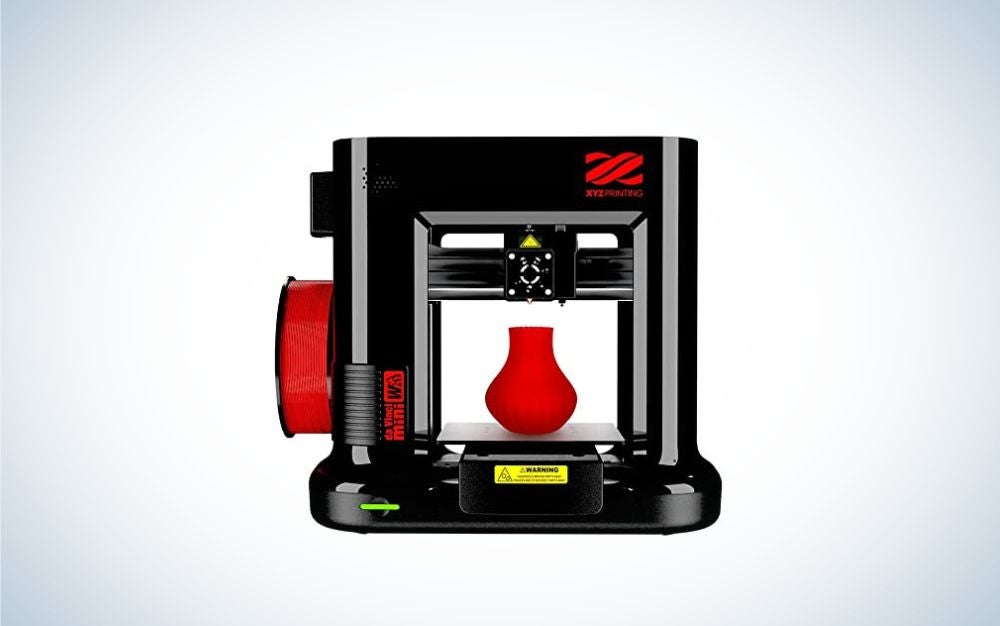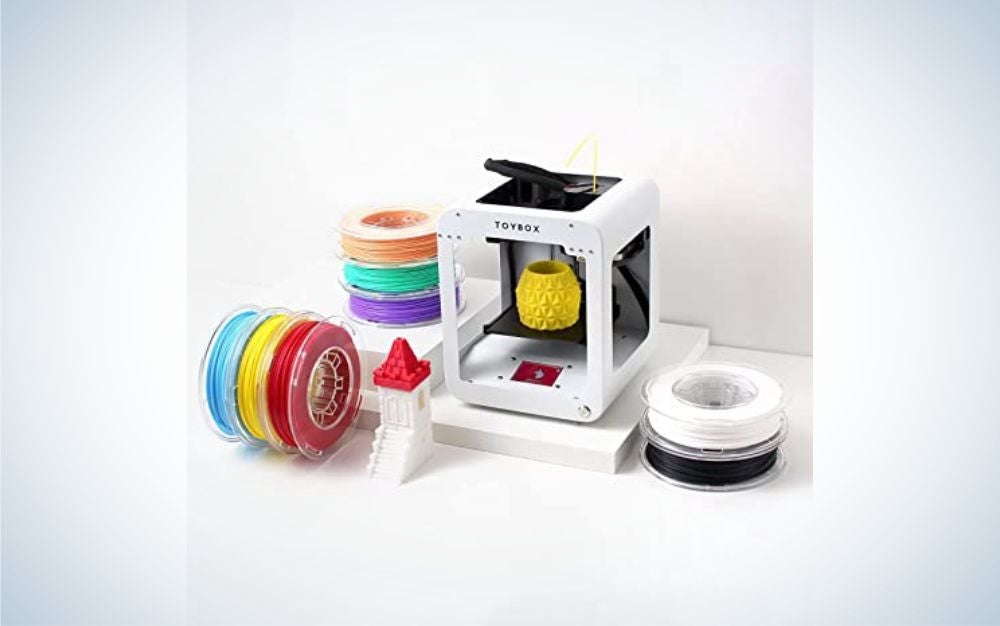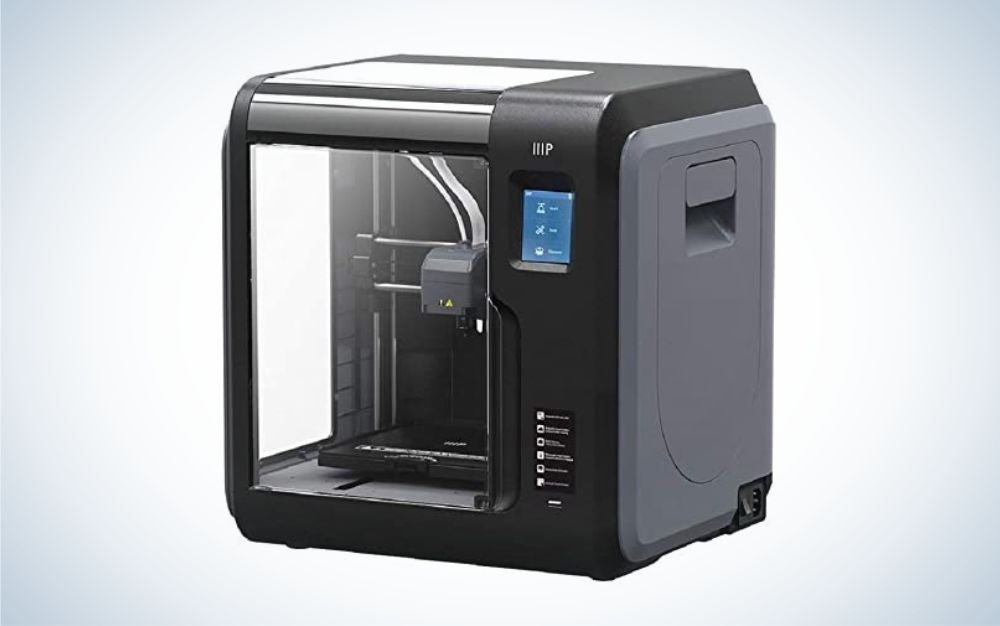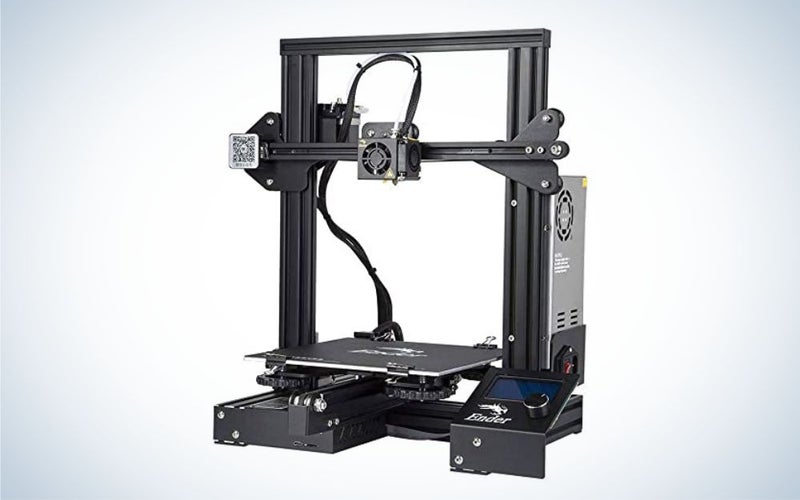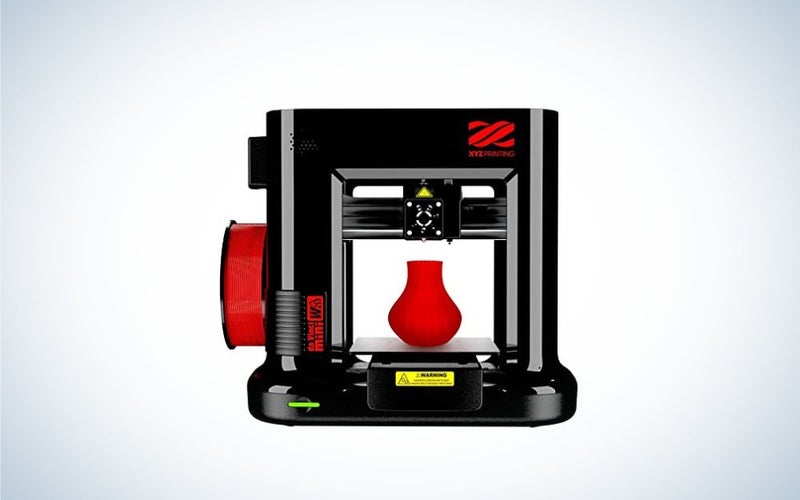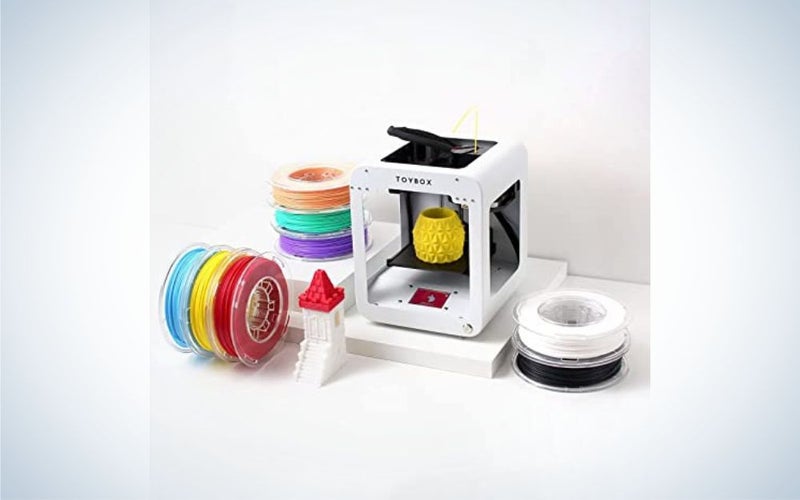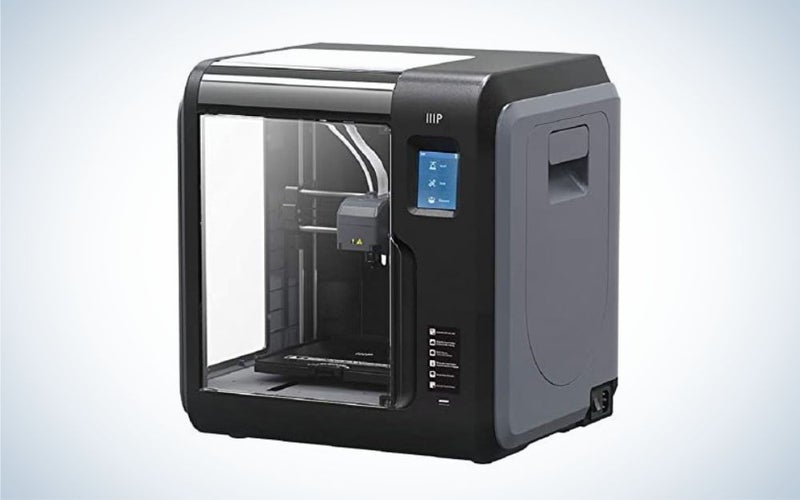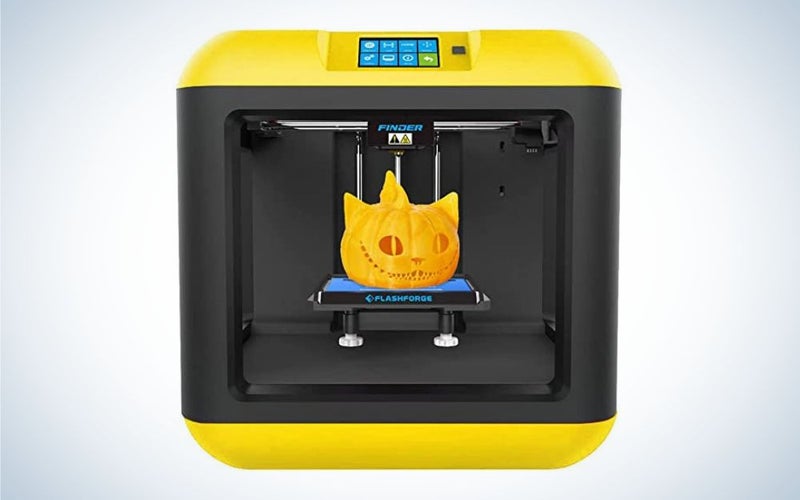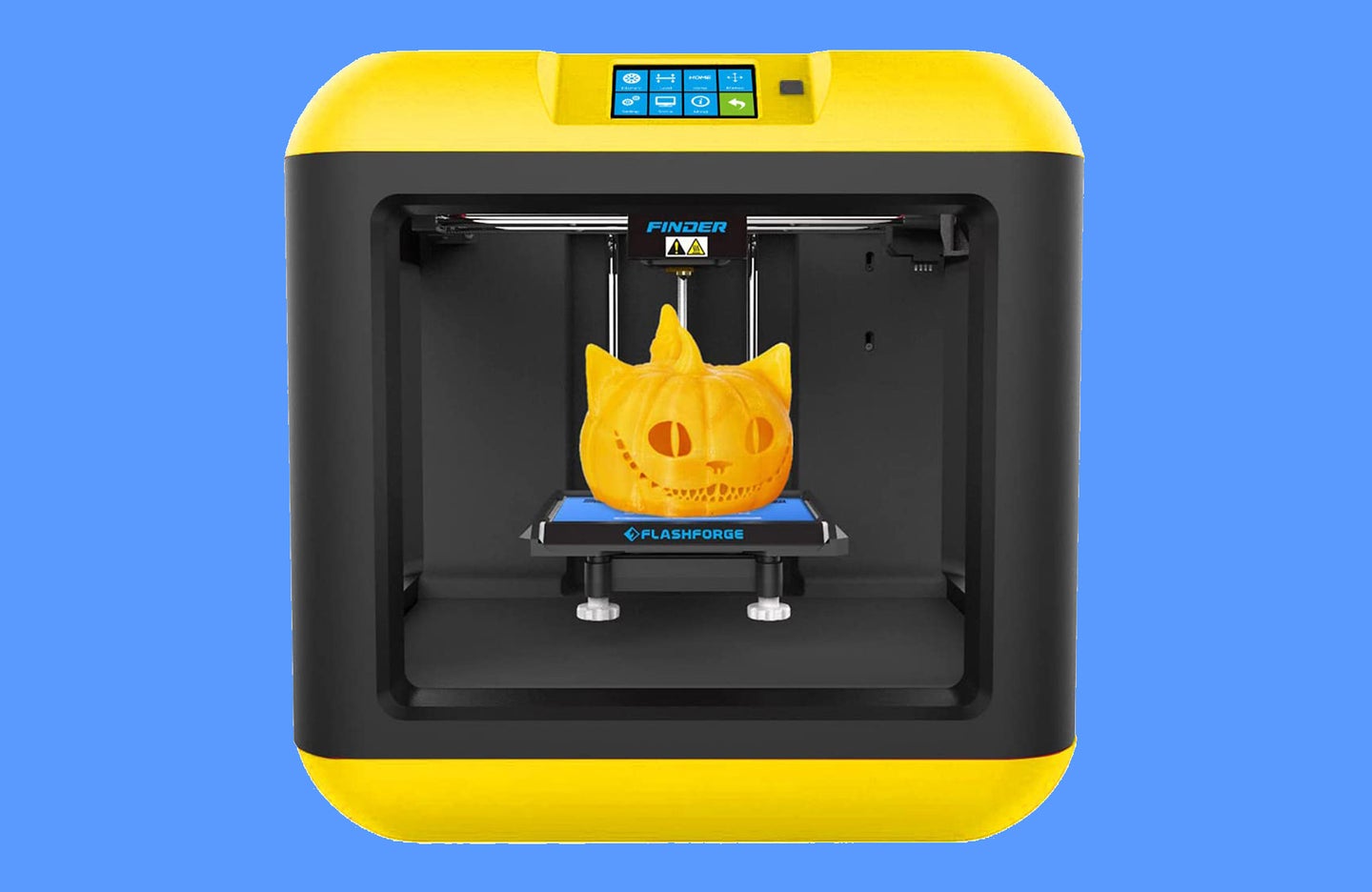
We may earn revenue from the products available on this page and participate in affiliate programs. Learn more ›
From creating custom-fitting prosthetics to delicate art projects, to greatly reduce the production time of intricate manufacturing, 3D printers have made an impact across the tech world. 3D printers once required huge budgets and hyper-specific skills, but they have become very accessible in recent years. Now, 3D printers come in small, affordable versions that you can keep in your home. Even those that kids can operate. Using 3D printers can come with many benefits for kids. They utilize problem-solving and teach subjects like science, art, and engineering. Each 3D printer can also help kids tap into their creative side. The best 3D printers for kids offer an ideal mix of usability, flexibility, and accessibility.
- Best overall: Creality Ender 3 3D Printer
- Best budget: DaVinci Mini Wireless
- Best kid-friendly: Toybox 3D Printer for Kids
- Best for teens: Monoprice Voxel
- Best for learning: FlashForge Finder 3D
How we chose the best 3D printers for kids
When choosing the best 3D printers for kids, we evaluated more than 15 printer brands and over 40 models of printers. We looked at performance, price, safety features, customer reviews, built-in features, and lifespan. We also looked at warranties (including products and customer service), and feedback from experts. Best-seller lists and purchaser responses were also taken into account.
Each product was rated on a scale and averaged, with a heavy focus on customer review and overall performance. We then included products that were appropriate for a variety of ages and skill levels to offer a well-rounded list for readers and those interested in child-friendly 3D printers.
Best 3D printers for kids: Reviews and recommendations
Best overall: Creality Ender 3 3D Printer
Comgrow
Why it made the cut: The Creality Ender 3 3D Printer is the best 3D printer for kids on a budget option and for veterans or anyone interested in taking their 3D printer knowledge to the next level.
Specs:
- 17.6 lbs.
- 8.7×8.7×9.8 lbs.
- Open-source printer compatible with PCs
Pros:
- Open-source, can be used with any software
- Extremely budget-friendly
- Advanced extruder technology for a reduction in clogs
Cons:
- Requires assembly (though veterans may enjoy the build)
- Learning curve to master to its highest potential
The Creality Ender 3 3D Printer is ideal for older kids or those familiar with 3D printing. It’s great on the wallet and allows for ample learning along the way. Use their step-by-step guide to build and calibrate your own 3D printer, then set up your favorite software for easy planning and printing. This model is ideal for the DIYer, tinkerer, or anyone wanting to up their electronic engineering skills to the third dimension.
There is a learning curve, but with more capabilities at your fingertips, this is a great option for older kids who want to do more than just point-and-print. Allow them to get their hands dirty and get a dose of engineering when setting up and planning each 3D build with their Creality Ender 3 model.
WIth the Creality Ender 3, users have the ability to start simple and get more complicated as their skills grow over time. Test the limits of this 3D printer and see what it can do. And because it’s open-source, you can switch programs or use more and more steps over time as your knowledge grows.
However, steer clear of the printing plate, as it’s not blocked off and could cause potential burns. While this allows for more flexibility, it may not be ideal for the youngest users.
This is one of the best 3D printers for kids and for anyone wanting to advance their engineering skills.
Best budget: DaVinci Mini Wireless
XYZprinting
Why it made the cut: The DaVinci Mini Wireless 3D printer offers an enclosed printing space that can be up and printing in no time – it offers zero setup time between plugging in and printing.
Specs:
- 22.1 lbs.
- 20x16x18 inches
- 200-micron printing resolution
Pros:
- Compatible with laptops, personal computers, or smartphones
- Can heat to suggested printing temperature of 245 degrees in less than one minute
- Print size up to 5.9′ x 5.9′ x 5.9
Cons:
- Only compatible with size 600G filament
- Does not host its own screen; must connect to another device
The DaVinci Mini Wireless 3D printer offers an absurdly fast heat-up time, which eliminates the need for waiting to print. It requires very little setup; simply plug it in, connect, and go. This is a great feature for kids (or impatient adults). It’s also a surprisingly rare feature among 3D printers; most require assembly or calibration before they’re functional. Meanwhile, a boxed-in printing area prevents the potential for burns and locks away heated progress from small hands.
This 3D printer can be used with a variety of filament types, including Polylactic Acid, Polyethylene Terephthalate Glycol, Polylactic Acid, those each must be 600G to maintain optimal high-speed printing capacities. Speeds are kept in check with a nozzle and print bed that move simultaneously, without sacrificing on small details. A 200-micron printing delta will also keep projects accurate and looking great, even with its quick printing speed.
At just 18 pounds, the DaVinci mini can easily be moved or stored away, while still offering sizable printing abilities, able to complete projects up to 5.9” all around. As a “mini,” it’s extremely versatile and able to tackle a number of projects larger than its size suggests. Consider it as a great addition to your new interest in 3D printing.
Best kid-friendly: Toybox 3D Printer for Kids
Toybox
Why it made the cut: The Toybox 3D Printer for Kids was made specifically for the use of young kids, down to its size. Hosting a catalog of thousands of toys (and updated weekly), kids will never run out of options. It even comes with its own filament so there’s no guessing on style or size.
Specs:
- 6.6 lbs.
- 7.4×7.4×9.05 inches
- 4mm smooth-flow extender head
Pros:
- Simple, one-touch functions
- Comes with multiple colors of filament
- Made for kids; unlimited catalog of toys. (Custom items can also be uploaded.)
Cons:
- Ample head-up time
- Requires computer calibration before printing, which may need repeated if moved.
The Toybox 3D Printer for Kids is an ideal model for younger kids interested in 3D printing. It was specifically designed with younger kids in mind, which means ease of use and simplicity at every turn. Printing and functions are a single click away, with buttons and clickable images on the display screen so kids can easily run the show.
With a huge catalog of toys, all kids have to do is load and hit “print.” New toy builds are also added weekly, creating an endless supply of projects to create. But you aren’t limited there; the Toybox app also allows for custom designs. Use ready-sent filament to avoid pricing out sizes or styles, then order more when you run out. (In competing devices, this can be a headache to find the right materials that meet compatibility standards.)
With a boxed-in print area, easy-peel print bed, and one-touch functions, this model was built specifically for kids and is simple and safe enough for them to use it on their own. Its small size and cloud-connect features allow for simple yet effective use, even without the use of outside tech or devices. And a lightweight build means kids can maneuver on their own, without the call for heavy equipment.
Best for teens: Monoprice Voxel
Monoprice
Why it made the cut: The Monoprice Voxel is a high-tech 3D printer that offers bells and whistles that are simple enough for first-time users. Complete with assisted leveling and a removable print bed, users have more flexibility with the 3D builds.
Specs:
- 19.6×16.9×20.2 inches
- 28.5 lbs.
- 5.9×5.9×5.9 in build plate
Pros:
- Comes with its own compatible tools
- 2.8” touchscreen control panel
- Built in hotspot capabilities and camera for remote viewing
Cons:
- Lengthier heat time
- Must use touchscreen interface to switch out parts
The Monoprice Voxel is a 3D printer that comes with plenty of upgrades, including a removable/flexible print bed, assisted leveling, and hotspot capabilities. Connect even without WiFi, then watch progress from a built-in camera that allows you to check in or adjust when you’re out of filament. These alone are a perk for the price, let alone combined. Not to mention, extremely rare in the world of electronics; few (if any) 3D printers offer their own hot-spotting abilities or remote camera options that are built directly into to the device.
It also comes with custom tools to switch out nozzles and more, and a large touchscreen to set up your project or make adjustments. No need to shop around for tools that fit, or learn how to complete your own work; the setup comes combined, ready for users of any skill level.
Meanwhile, it prints at a whopping 60mm per second, whipping through any project up to 5.9×5.9×5.9 inches. Showing up fully calibrated, users can spend more time on printing and less time setting up their new 3D printer.
Offering bang for the buck, this printer has plenty of bells and whistles, without complicated knowledge to put it into action.
Best for learning: FlashForge Finder 3D
FlashForge
Why it made the cut: The FlashForge Finder 3D printer is a full-scale 3D printer that comes with a convenient slide-out tray, assisted leveling options, and a color touchscreen that’s larger than the competition.
Specs:
- 24.3 lbs
- 16.54×16.54×16.54 inches
- 3.5-inch color touchscreen
Pros:
- Quiet printing – operates at just 50 decibels
- Comes with compatible tools for maintenance
- Prints on a cool-touch plate
Cons:
- Needs to be calibrated (with screen-provided instructions)
- Requires software updates
Get the best of both worlds with FlashForge Finder 3D’s mix of manual and automatic features. It’s a great transition for learning how to work on your 3D printer, without the stress of having to get it all perfect on your first go-round.
But that’s not all, with ready-to-print options, users can hit the ground running once their printer model is completely assembled. Adjust your filament with ease, thanks to the FlashForge Finder 3D’s provided tools. Printing onto a cool-touch plate, users can learn how to program, maintain, and update their 3D printer thanks to this model’s user-friendly profile.
Meanwhile, features like quiet printing and assisted leveling to allow you to create finished products without the headache associated with a manual or freestanding model. Learn as you go and continue to create more complicated builds in a quiet, user-friendly setting. At just 50 decibels, this printer can blend in with background noise. It’s great for kids who dislike loud noises, or with families who have kids who nap or can be easily distracted.
The FlashForge Finder is a great way to upgrade your 3D printing skills. It’s best for older kids or those who have a love for science and building and want to grow their skillset.
FAQs
Q: How much do 3D printers cost?
3D printers vary greatly when it comes to price. From around $170 up to nearly $1,000, it’s important to look at the features, size, and abilities that are important to you before purchasing. Not all budget models are low-quality, and not all luxury price tags are worth their weight. Refer to the above features to help find the best 3D printer for kids that will best meet your budget and expectations.
Q: Can a kid use a 3D printer?
Absolutely! There are many 3D printer models that are great for kids of all ages and skill levels. Be sure to pay attention to various features to find one that is most appropriate for your kids. Some main features to consider are: size and weight of the 3D printer if it has a closed-off printing area (which locks away heated elements of the printer), and the sound level. You should also consider your child’s interest level in building and planning, as some models offer far more sophisticated options.
Q: What age is good for a 3D printer?
Every child is different, but thankfully there are many levels of 3D printers available. So long as you plan to help with the setup and printing process, kids can start as young as two or three years old. (So long as they are mature enough to keep their hands to themselves and follow instructions.) Starting around 4 or 5, kids will be able to get more involved in the process, especially with models geared toward little kids.
Q: Are 3D printers hard to use?
Available 3D printers come with all skill sets in mind, from those who have never once even thought about using a 3D printer, to those who have years of experience building electronics and attaching relevant software. Before purchasing a model, look at its capabilities and level of difficulty so you can easily find one that meets your expectations, wants, and preferred performance level.
Things to Consider Before Buying a 3D Printer for Kids
When choosing the best 3D printers for kids, you have some decisions to make. Like any technology, there are products with flashy add-ons (and the flashy price tags to go with them), there are 3D printers that just offer the basics. Of course, retailers also offer just about everything in between.
But when it comes to choosing a 3D printer for kids, safety is one of the first features you’ll want to keep in mind. Learning curve and ease of assembly also play huge factors in whether or not your little one will enjoy the overall process. Kids can have shorter attention spans than adults, while 3D printers that have complicated maintenance issues will go over young users’ heads.
How safe is a 3D printer?
One of the best ways to ensure a 3D printer is safe for kids is to purchase a version that is boxed-in. A 3D printer with open concept printing can expose hot elements to the air, while a boxed-in version will be closed off while it’s printing. The Artillery Sidewinder S1 and Nantfun Mini 3d Printer are examples of the former, and while they are high-quality 3D printers, they may not be suitable for young kids. Meanwhile, the flashforge 3d printer offers an enclosed box that locks away all of the 3D printing fun from small hands. You should also consider a 3D printer that has elements that are cool to the touch, including the printing tray and filament features.
Of course, heat is often necessary in order to use the most common types of 3D printers, after all it’s fusing melted plastic together. But by choosing a model that cools quickly or locks away the features that hold heat, you can find a 3D printer that is better for kids. This is especially true of young kids or those who have a harder time following instructions.
Maintenance
Another aspect to consider is how long it takes to load your next printing color, or to replace parts after they’re worn down. This can often take place mid-print, and if you don’t do your research, you could be stuck with a model that needs ample cooling or load time.
You can also consider the speed of the printer itself; the Anycubic 3d printer operates at a speed of 50mm per hour, helping your creation truck right along. Other models have slower speeds, which can add up when printing larger items.
3D printing with kids and sensory disorders
If you have a child who is sensitive to various senses, planning around that factor is at the forefront of your mind at all times. Take note that some senses that may trigger kids include: loud noises, strange sounds, the feel of the plastic at various stages.
Luckily, you can plan around these changes. The Kingroon KP3S can be used on a “mute print” setting to help eliminate as much 3D printing noise as possible. The Voxelab Aquila (3,8k) is built out of an aluminum frame, which eliminates shaking while printing. (Consider the sound of shaking plastic in other models). The Creality Ender 3 (16k) also helps cut sound with the addition of a silent motherboard while in use.
Final thoughts regarding the best 3D printers for kids
While many people still consider 3D printers advanced machines meant for older users, the current generation of devices can be a great way for little ones to flex their engineering muscles. We recommend something that’s easy to pick up and use, but offers room to grow for those who really take to it.
The post Best 3D printers for kids in 2022 appeared first on Popular Photography.
